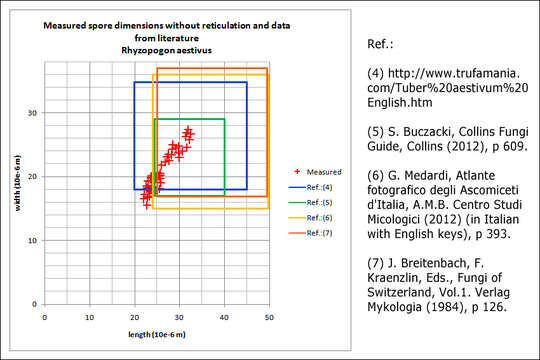Rhyzopogon-aestivus_spore_stat_2M

Description:
Rhizopogon aestivus (Wulfen) Fr., syn.: Tuber aestivum (Wulfen) Spreng., Tuber uncinatum Chatin, Tuber aestivum Vittad. (nom.illegit.), Hymenangium aestivum (Wulfen) Rabenh., Lycoperdon aestivum WulfenBlack summer truffle, Summer Truffle, DE: Sommer-Trffel, Burgunder-TrffelSlo.: poletna gomoljkaDat.: Nov. 3. 2016Lat.: 46.35962 Long.: 13.70446Code: Bot_1026/2016_DSC6356Habitat: mixed wood, Fagus sylvatica and Picea abies dominant trees; moderately inclined mountain slope, southeast aspect; skeletal, colluvial, calcareous ground; in shade; relatively warm and dry place; partly protected from direct rain by tree canopies; average precipitations ~ 3.000 mm/year, average temperature 7-9 deg C, elevation 560 m (1.840 feet), alpine phytogeographical region.Substratum: on soil, covered by forest ground humus, mainly rotten leaves of Fagus sylvatica.Place: Lower Trenta valley, between villages Soa and Trenta, right bank of river Soa, near Skokar farm house, Trenta 2, East Julian Alps, Posoje, Slovenia EC. Comments: Naming members of genus Tuber is a problem for me. Different sources have different approaches. I am following Index Fungorum (current name Rhizopogon aestivus (former Tuber aestivum)). This disagrees with MycoBank and Ref.: 2, 6 and 7. Also, according to Ref.:2, molecular analysis showed no differences between Tuber aestivum and Tuber uncinatum. Therefore they are synonymized or T. uncinatum considered as a variety as a variety of T. aestivum. Another taxon - Tuber mesentericum - is very similar to Tuber aestivum. When old they are hard to separate (Ref.2). They have been synonymized or considered a Tuber aestivum variety by some authors; however molecular analysis showed that they are two different species (Ref.2). Macro and micro traits of this find correspond well to Rhizopogon aestivus = Tuber aestivum. However, a possibility that the find is Tuber mesentericum cannot be completely excluded according to Ref.2. Although a hypogeous fungus, I found it only half-buried in forest ground humus and Fagus sylvatica leaves. I noticed it without any digging. This sometimes happens when animals dig them for food and then leave them there uneaten. Tuber aestivum is mycorrhizal with roots of several trees, almost certainly with Fagus sylvatica in this find. But when fruitbody becomes larger than about 1 cm in diameter they can thrive further also on ground as a saprophytic fungus (Ref.:1).Orange blobs on the surface of the Tuber are a parasitic anamorph fungus. The fusiform conidia obviously belong to genus Fusarium (Ref.:3).Growing solitary; fruitbody quite old (over-mature), 38 mm across; surface covered with black, large, 4-6 sized pyramidal warts; no cavity at the bottom seen; the pattern of white veins seen in cross-section does not correspond well to usual pattern for this species (too few and too coarse), but this can be explained by over-maturity of the fruitbody (numerous fine veins disappear with age according to Ref.: 1); smell indistinctive, not strong, which often happens with over-ripen fruitbodies (Ref.:2); taste not tested; spore mass dark brown, almost black.Spores very coarsely reticulated; about 3 meshes across front view, ridges up to 6 microns high. Ascospores' dimensions (without reticulation): 20 [25.2 ; 26.9] 32.1 x 14.7 [19.9 ; 21.7] 26.9 microns; Q = 1.1 [1.2 ; 1.3] 1.4; N = 51; C = 95%; Me = 26 x 20.8 microns; Qe = 1.3; gleba consisting almost entirely from spores. Asci (remnants of them) seen only at few places (see picture 3M). Olympus CH20, NEA 40x/0.65, magnification 400x; fresh material; in water. AmScope MA500 digital camera.Herbarium: Mycotheca and lichen herbarium (LJU-Li) of Slovenian Forestry Institute, Vena pot 2, Ljubljana, Index Herbariorum LJFRef.:(1) Personal communication with Mr. Andrej Piltaver, Institute for Systematic of Higher Fungi, Ljubljana, SI. (2) Personal communication with Antonio Rodrguez, www.trufamania.com.(3) Personal communication with Dr. Walter Gams, www.ascofrance.com.(4) www.trufamania.com/Tuber aestivum English.htm (5) S. Buczacki, Collins Fungi Guide, Collins (2012), p 609. (6) G. Medardi, Atlante fotografico degli Ascomiceti d'Italia, A.M.B. Centro Studi Micologici (2012) (in Italian with English keys), p 393. (7) J. Breitenbach, F. Kraenzlin, Eds., Fungi of Switzerland, Vol.1. Verlag Mykologia (1984), p 126.
Included On The Following Pages:
This image is not featured in any collections.
Source Information
- license
- cc-by-nc-sa
- copyright
- Amadej Trnkoczy
- photographer
- Amadej Trnkoczy
- original
- original media file
- visit source
- partner site
- Flickr Group
- ID


